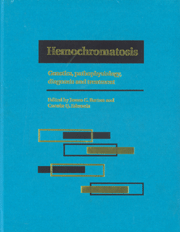Book contents
- Frontmatter
- Contents
- List of contributors
- Foreword
- Part I Introduction to hemochromatosis
- Part II Genetics of hemochromatosis
- Part III Metal absorption and metabolism in hemochromatosis
- 10 Intestinal iron-binding proteins
- 11 Intestinal iron absorption and hemochromatosis
- 12 The absorption and metabolism of non-ferrous metals in hemochromatosis
- 13 Ferritin metabolism in hemochromatosis
- 14 Hepatic iron metabolism in hemochromatosis
- 15 Extra-hepatic iron metabolism in hemochromatosis
- 16 Mathematical models of metal metabolism in hemochromatosis
- 17 Expression of iron overload in hemochromatosis
- Part IV Diagnostic techniques for iron overload
- Part V Complications of iron overload
- Part VI Therapy of hemochromatosis and iron overload
- Part VII Infections and immunity in hemochromatosis
- Part VIII Hemochromatosis heterozygotes
- Part IX Relationship of hemochromatosis to other disorders
- Part X Animal models of hemochromatosis and iron overload
- Part XI Screening for hemochromatosis
- Part XII Hemochromatosis: societal and ethical issues
- Part XIII Final issues
- Index
15 - Extra-hepatic iron metabolism in hemochromatosis
from Part III - Metal absorption and metabolism in hemochromatosis
Published online by Cambridge University Press: 05 August 2011
- Frontmatter
- Contents
- List of contributors
- Foreword
- Part I Introduction to hemochromatosis
- Part II Genetics of hemochromatosis
- Part III Metal absorption and metabolism in hemochromatosis
- 10 Intestinal iron-binding proteins
- 11 Intestinal iron absorption and hemochromatosis
- 12 The absorption and metabolism of non-ferrous metals in hemochromatosis
- 13 Ferritin metabolism in hemochromatosis
- 14 Hepatic iron metabolism in hemochromatosis
- 15 Extra-hepatic iron metabolism in hemochromatosis
- 16 Mathematical models of metal metabolism in hemochromatosis
- 17 Expression of iron overload in hemochromatosis
- Part IV Diagnostic techniques for iron overload
- Part V Complications of iron overload
- Part VI Therapy of hemochromatosis and iron overload
- Part VII Infections and immunity in hemochromatosis
- Part VIII Hemochromatosis heterozygotes
- Part IX Relationship of hemochromatosis to other disorders
- Part X Animal models of hemochromatosis and iron overload
- Part XI Screening for hemochromatosis
- Part XII Hemochromatosis: societal and ethical issues
- Part XIII Final issues
- Index
Summary
Introduction
Body iron balance normally remains relatively constant over time. Because humans have no mechanism for regulating the rate of iron excretion, this balance must be maintained by control of intestinal iron absorption. Excessive iron absorption in patients with hemochromatosis leads to body iron overload, the hallmark of the disease. The pattern of increased tissue iron deposition is quite characteristic, with progressive iron accretion in parenchymal cells of the liver and many other organs, but relatively little iron accumulation in reticuloendothelial cells such as hepatic Kupffer cells or bone marrow macrophages until late in the course of the disease. This distribution pattern represents an enigma, given the normal role of the reticuloendothelial system (RES) in iron storage, and raises the possibility of a combined defect in hemochromatosis that involves not only the absorptive epithelium of the gastrointestinal tract but also the RES.
The discovery of a strong candidate gene for hemochromatosis (HFE) promises to accelerate progress toward elucidation of the biochemical basis of the disease. Most hemochromatosis patients are homozygous for a missense mutation in HFE that produces a Cys-282 → Tyr substitution (C282Y). A second mutation, His-63 → Asp (H63D), is found in some hemochromatosis patients who are heterozygous for the C282Y mutation. The function of the normal gene product is unknown, however, nor is it understood how these mutations alter iron metabolism in affected individuals. This chapter will focus on studies of iron kinetics in hemochromatosis patients and the significance of these studies for understanding the mechanism of the increased iron absorption in this disorder.
- Type
- Chapter
- Information
- HemochromatosisGenetics, Pathophysiology, Diagnosis and Treatment, pp. 163 - 169Publisher: Cambridge University PressPrint publication year: 2000



